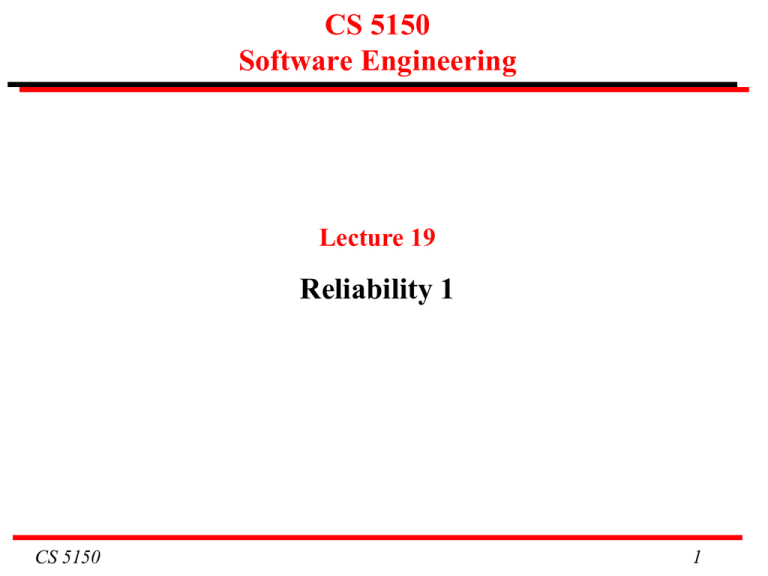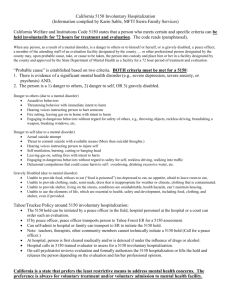CS 5150 Software Engineering Reliability 1 Lecture 19
advertisement

CS 5150 Software Engineering Lecture 19 Reliability 1 CS 5150 1 Dependable and Reliable Systems: The Royal Majesty From the report of the National Transportation Safety Board: "On June 10, 1995, the Panamanian passenger ship Royal Majesty grounded on Rose and Crown Shoal about 10 miles east of Nantucket Island, Massachusetts, and about 17 miles from where the watch officers thought the vessel was. The vessel, with 1,509 persons on board, was en route from St. George’s, Bermuda, to Boston, Massachusetts." "The Raytheon GPS unit installed on the Royal Majesty had been designed as a standalone navigation device in the mid- to late 1980s, ...The Royal Majesty’s GPS was configured by Majesty Cruise Line to automatically default to the Dead Reckoning mode when satellite data were not available." CS 5150 2 The Royal Majesty: Analysis • The ship was steered by an autopilot that relied on position information from the Global Positioning System (GPS). • If the GPS could not obtain a position from satellites, it provided an estimated position based on Dead Reckoning (distance and direction traveled from a known point). • The GPS failed one hour after leaving Bermuda. • The crew failed to see the warning message on the display (or to check the instruments). • 34 hours and 600 miles later, the Dead Reckoning error was 17 miles. CS 5150 3 The Royal Majesty: Software Lessons All the software worked as specified (no bugs), but ... • Since the GPS software had been specified, the requirements had changed (stand alone system now part of integrated system). • The manufacturers of the autopilot and GPS adopted different design philosophies about the communication of mode changes. • The autopilot was not programmed to recognize valid/invalid status bits in message from the GPS (NMEA 0183). • The warnings provided by the user interface were not sufficiently conspicuous to alert the crew. • The officers had not been properly trained on this equipment. CS 5150 4 Key Factors for Reliable Software • Organization culture that expects quality • Software design and implementation that hides complexity (e.g., structured design, object-oriented programming) • Precise, unambiguous specification • Software tools that restrict or detect errors (e.g., strongly typed languages, source control systems, debuggers) • Programming style that emphasizes simplicity, readability, and avoidance of dangerous constructs • Incremental validation (e.g., reviews, unit testing) • Systematic testing (test plan, test cases, etc.) • Change management (regression testing) CS 5150 5 Building Dependable Systems: Organizational Culture Good organizations create good systems: • Acceptance of the group's style of work (e.g., meetings, preparation, support for juniors) • Visibility – tell people your problems • Completion of a task before moving to the next (e.g., documentation, comments in code) CS 5150 6 Building Dependable Systems: Three Principles For a software system to be dependable: • Each stage of development must be done well. • Changes should be incorporated into the structure as carefully as the original system development. • Testing and correction do not ensure quality, but dependable systems are not possible without systematic testing. CS 5150 7 Building Dependable Systems: Quality Management Processes Assumption: Good software is impossible without good processes The importance of routine: Standard terminology (requirements, specification, design, etc.) Software standards (coding standards, naming conventions, etc.) Regular builds of complete system Internal and external documentation Reporting procedures CS 5150 8 Building Dependable Systems: Quality Management Processes When time is short... Pay extra attention to the early stages of the process: feasibility, requirements, design. There will be little time to redo mistakes in the requirements. Experience shows that taking extra time on the early stages will usually reduce the total time to release. CS 5150 9 Building Dependable Systems: Involve the Client Specifications are of no value if they do not meet the client's needs • The client must understand and review the requirements in detail. • Appropriate members of the client's staff must review relevant areas of the design (including operations, training materials, system administration). • The acceptance tests must belong to the client CS 5150 10 Building Dependable Systems: Changes Feasibility study Requirements System design Program design Implementation (coding) Changes Testing Acceptance & release Operation & maintenance CS 5150 11 Building Dependable Systems: Change Change management: Source code management and version control Tracking of change requests and bug reports Procedures for changing requirements specifications, designs and other documentation Regression testing Release control CS 5150 12 Building Dependable Systems: Complexity The human mind can encompass only limited complexity: • Comprehensibility • Simplicity • Partitioning of complexity A simple component is easier to get right than a complex one. CS 5150 13 Reliability Metrics Reliability Probability of a failure occurring in operational use. Perceived reliability Depends upon: user behavior set of inputs pain of failure CS 5150 14 Reliability Metrics Traditional measures for online systems • Mean time between failures • Availability (up time) • Mean time to repair Market measures • Complaints • Customer retention User perception is influenced by • Statistical distribution of failures CS 5150 15 Metrics: User Perception of Reliability 1. A personal computer that crashes frequently, or a machine that is out of service for two days. 2. A database system that crashes frequently but comes back quickly with no loss of data, or a system that fails once in three years but data has to be restored from backup. 3. A system that does not fail but has unpredictable periods when it runs very slowly. CS 5150 16 Reliability Metrics for Distributed Systems Traditional metrics are hard to apply in multi-component systems: • A system that has excellent average reliability might give terrible service to certain users. • In a big network, at any given moment something will be giving trouble, but very few users will see it. • When there are many components, system administrators rely on automatic reporting systems to identify problem areas. CS 5150 17 Requirements Metrics for System Reliability Example: ATM card reader Failure class Example Metric (requirement) Permanent System fails to operate non-corrupting with any card -- reboot 1 per 1,000 days Transient System can not read non-corrupting an undamaged card 1 in 1,000 transactions Corrupting Never CS 5150 A pattern of transactions corrupts database 18 Metrics: Cost of Improved Reliability Example. Many supercomputers average 10 hours productive work per day. How do you spend your money to improve availability? Cost $ 95% CS 5150 Reliability 100% metric 19 Example: Central Computing System A central computer system (e.g., a server farm) is vital to an entire organization. Any failure is serious. Step 1: Gather data on every failure • Many years of data in a data base • Every failure analyzed: hardware software (default) environment (e.g., power, air conditioning) human (e.g., operator error) CS 5150 20 Example: Central Computing System Step 2: Analyze the data • Weekly, monthly, and annual statistics Number of failures and interruptions Mean time to repair • Graphs of trends by component, e.g., Failure rates of disk drives Hardware failures after power failures Crashes caused by software bugs in each component CS 5150 21 Example: Central Computing System Step 3: Invest resources where benefit will be maximum, e.g., • Priority order for software improvements • Changed procedures for operators • Replacement hardware • Orderly shut down after power failure CS 5150 22
